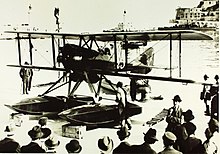Nieuport-Delage Ni-D.29
| Nieuport-Delage Ni-D.29 | |
|---|---|
 Nieuport-Delage Ni-D 29 C.1 |
|
| Type: | Fighter plane |
| Design country: | |
| Manufacturer: | |
| First flight: |
1918 |
The Nieuport-Delage Ni-D 29 was a single-seat fighter aircraft. The biplane was mainly used during the 1920s.
Development history
The prototype of the single-seat combat aircraft (Category C.1) Nieuport-Delage Ni-D 29 , a biplane with the same wingspan and ailerons on the upper and lower wings, made its first official test flight on August 21, 1918. The model performed well , except for the planned summit height, which it did not reach. The second prototype also had a Hispano-Suiza 8Fb engine and the slim fuselage with the round cross-section of its predecessor; the span was somewhat widened. After the prescribed peak height had been reached, the Ni-D 29 went into series production in early 1920.
The series machines were improved in details; the most striking difference was the lack of ailerons on the upper wings and the enlargement of the lower wings. First deliveries to the French Aviation Militaire were carried out in 1922; the type went to the Escadrilles SPA 37, 81 and 91 (later renamed 101, 102 and 103), which were stationed in Germany. The Ni-D 29 became popular, although pilots criticized the machine's tendency to spin. Around 250 copies were built by Nieuport and seven other companies for the French military. between 1922 and 1924 a total of 18 orders were received.
The Ni-D 29 was soon the most important fighter aircraft of the 1920s. Among the French Ni-D 29 that were used against Rif insurgents in Morocco there were also some specimens that had been brought to the B.1 standard and could accommodate small bombs. The Spanish Nieuport also took part in the fight against the North African insurgents.
variants
Ni-D 29 BI
Experimental attack version of the fighter aircraft with six 10 kg bombs; the famous pilot Sadi Lecointe earned three honorable mentions and his promotion with a Ni-D 29 B.1; only a small number of machines were converted to this configuration.
Ni-D 29bis
The Ni-D 29bis was exhibited during the Paris Air Show in 1922 ; it had a reduced wing area and a controllable tail spur, only a prototype was built.
Ni-D 29G
Version with Gnome 9N rotary engine built parallel to the prototypes with Hispano motors ; the first of two copies was later modified for the Hispano engine and equipped with two main floats and a stern auxiliary float; the machine then took part in the seaplane meeting for the Grand Prix de Monaco of 1920; the second specimen was tested with the Gnome engine as a possible carrier-based fighter and then converted in 1920 as the Ni-D 32RH with a Le Rhône 9R with 180 PS (134 kW).
Ni-D 29D
A machine converted for an altitude record; thanks to a Rateau loader, the specimen reached a height of 7,000 m.
Ni-D 29 EI
School variant built for the Aviation Militaire with a Hispano-Suiza engine with 180 hp (134 kW) and a synchronized Vickers rifle.
Ni-D 29 SHV
Seaplane variant for the 1919 Schneider Trophy race ; Wingspan reduced to 8.00 m and airframe without military equipment; two copies were built and one was registered in 1921; no Ni-D 29 took part in the actual competition.
Ni-D 29V
Light racing aircraft developed in 1929 by the designer Mary together with the company engineer Gustave Delage with a wingspan of only 6.00 and a Hispano-Suiza 8FB with 320 HP (239 kW); the maximum take-off mass was only 936 kg; the three racing planes built were modified several times and were successful at various events. Sadi Lecointe won the Coupe Deutsch in 1919 and the Gordon Bennett Trophy in 1920 with Ni-D 29V.
Ni-D 29V to
The Ni-D 29V bis was a converted machine that should achieve a higher speed by omitting the open cockpit with its windshield and headrest; the pilot crouched in the fuselage and could only see outside through tiny windows; the destruction of the machine in a landing accident in April 1921 was no surprise.
Users
-
 Argentina about 10 machines
Argentina about 10 machines -
 Belgium 108 machines (including 87 manufactured by SABCA under license);
Belgium 108 machines (including 87 manufactured by SABCA under license); -
 Spain 30 machines, ten of them built under license in Spain
Spain 30 machines, ten of them built under license in Spain -
 France 250 machines
France 250 machines -
 Italy 6 machines (175 additionally manufactured by Macchi & Caproni under license)
Italy 6 machines (175 additionally manufactured by Macchi & Caproni under license) -
 Japan 1 machine (Nakajima also built no fewer than 608 KO-4 licensed machines)
Japan 1 machine (Nakajima also built no fewer than 608 KO-4 licensed machines) -
 Sweden 9 machines
Sweden 9 machines -
 Thailand 12 machines (others manufactured under license)
Thailand 12 machines (others manufactured under license)
Technical specifications
| Parameter | Data |
|---|---|
| crew | 1 |
| length | 6.49 m |
| span | 9.70 m |
| height | 2.56 m |
| Wing area | 26.70 m² |
| Empty mass | 760 kg |
| Takeoff mass | 1150 kg |
| drive | an eight-cylinder - V-engine Hispano-Suiza 8 Fb with 224 kW (300 hp) |
| Top speed | 235 km / h |
| Range | 580 km |
| Service ceiling | 8500 m |
| Armament | two rigid, forward-firing 7.7 mm Vickers machine guns |


